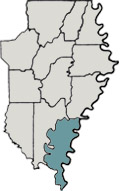Introduction to Delta Pieces: Northeast Louisiana Folklife
Map: Cultural Micro-Regions of the Delta, Northeast Louisiana

The Louisiana Delta: Land of Rivers








Ethnic Groups










Working in the Delta








Homemaking in the Delta



Worshiping in the Delta



Making Music in the Delta




Playing in the Delta







Telling Stories in the Delta



Delta Archival Materials
Bibliography

Guy Serio
Concordia Parish
Guy Serio opened Serio's Super Mart in Ferriday, La. in 1932. His family is of Sicilian origin.

Guy Serio: "They Had a Rough Go": Italians in the Delta
By Madelyn Boudreaux
Guy Serio, born in 1907, lived in the Delta all his life. His family, originally from Sicily, Italy, came into the United States through the port in New Orleans, rather than through New York, and moved to Newellton, Louisiana, in 1906. He grew up in Newellton, and moved to Ferriday in 1924. In 1932, he opened a grocery store, Serio's Super Mart, which he was still operating in1994. Most of the Italians—in fact, almost everyone—he knew were now dead by 1994; he says he is the only old one left, and he lists off those who have died as proof. All the others have left; they moved out to California when they could. Many of these made the fortune for which they had hoped.
In 1994, many customers came into the store to pick up a few groceries. Most used food stamps, which led Serio to talk about the troubles people face today and the troubles his family and friends have faced. Serio explains the history of the Delta Italians:
Most of [the Italian settlers in the Delta] started out 1900, 1906, 1910—that's when most of them came to this country. They traveled on the Mississippi River on boats, that's kind of slow going, though. These Italians came in here all up and down the river, they went on in to Tallulah, Lake Providence, on up into Arkansas. I think some of them still in Arkansas, where they . . . still raise grapes up there, Concorde grapes, make jelly. Lot of them in Monroe, too.
These were probably the groups brought to Louisiana to replace the absent African American laborers, who had moved out of the Delta region after the Civil War, although others he describes apparently came into the area in 1907-08 via the railroad lines on which they worked. After laying down the railroad lines, many Italians settled near the lines under the encouragement of the companies; the Italians worked hard to maintain the lines, and the land flourished where they settled. (Gambino 91)1
Although the Delta is fertile, the Italian tenant farmers apparently found it far too difficult, as Serio reports:
Some of these big planters would let some of them come in on their place, you know, big planters, the farm—back those days, they had mostly cotton, and they tried to raise cotton, which they never did raise no cotton where they came from, but they tried anyway. They'd work a year or two, couldn't make anything, hardly a living, well they had to do it all by hand. The mules—picking cotton by hand, well they were too smart for that, they were all hard workers, so they saved up enough money, a lot of them did, and went to California, and grew the stuff they were used to over in Italy. Like grapes, fruit, all that stuff. Particularly around San Francisco and the south. They had a bank in San Francisco; it was a large, large bank. The name of it was the Bank of Italy—in San Francisco, and they would loan them money to get started.2 Some of them are big, big, rich people today. Some of them made wine—it's one of the largest in the world today, those wine-makers of California. I guess you've heard of them. . . . Anyway, lot of them went to California.
It was difficult for them to earn even enough money to go to California, however. Some bought their own land, only to lose it later, when the crops were poor. When asked why it was so hard to grow successful crops, compared to the thriving cotton-fields of today, Serio laughed rather bitterly and pointed out that they had to do it all by hand. Today everything is done with tractors, and "you don't have a mule, you can't find a mule in the country now. Or a horse. . . . All the mules did all the plowing and stuff like that." Finally, others simply moved across the river to Natchez, although no one seems to know why they did this. For example, the Sam May family "tried it for a long time, fooling with cotton—I would say 7, 8, maybe 10 years, couldn't make it. They left there and went to Natchez." Another man, Claude Zaconi tried rice farming; he then moved to Arkansas, where he tried to grow cotton, moved Newellton, "and that's where he went broke" (Serio).
Other terrible disasters occurred; at one point, unable to afford oats, a family had to feed the mules green corn. The mules got sick, and two or three were lost. At that time, Mr. Serio said, a pair of mules cost $600. Another time, when the cotton didn't work out, they tried logging. This didn't last long either, as it destroyed mules and horses alike, according to Serio: "One of the horses I knew went blind pulling." These sorts of hardships caused many to leave such an inhospitable land.
Those Italians who did remain were not exclusive, and mixed freely with the non-Italians around them, most of whom were Catholic. As in other areas where few Italians remained, the Italian-Americans of the Delta assimilated into the larger society. Many of the Italians who did stay in Ferriday were proprietors of restaurants and shops and did not rely as heavily on the arduous farming.3 Still, it was difficult even for businessmen to make a living, since they relied on the unstable farmers for their livelihood. In Newellton, Serio's father "had a store, dry goods, mercantile, sold ice, and buggies" (Serio). He also sold furniture, but when the crops were poor, his patrons were unable to pay, and he lost everything. He then went into farming cotton. He had little in the way of equipment, and "all the rest of it, he had to do by hand or foot" (Serio). Serio reiterated several times that everyone, not just Italians, had an equally hard time: "Some of them had a pretty hard life. Back in those days, a lot of people had a hard life. You don't imagine how hard it really was." However, his comments about life today sometimes reflected well on those times; while it was hard to make a living, people could still live off the land; today that is an impossibility. There were far fewer robberies, and children expelled from elementary school didn't shoplift in his store. When making grocery deliveries, Serio was often asked to put the perishables in the ice-box, which is, he commented, "unheard of today." Back then, he said, "a dollar was worth a dollar," although few people had many (Serio).
When the economy wasn't threatening them, the geography was. Floods are a constant danger in the Eastern Delta, and Louisiana rainfall exacerbated the problems. Even cars didn't solve all the problems of travel, according to Serio: "During the Model-T days, it was rough.4 They had these dirt roads; you had to be a good driver in the winter time just to get through some of these mud holes. You had to hit 'em just right to come on out. If you didn't, you was stuck, particularly in this part of the country."
Although Ferriday "was incorporated in 1904," Serio feels he helped to build the town. He served ten straight times on the town council, "a record in the state." He believes that his store was the first "self-service store in the whole parish. Today it's the oldest store that still exists, that's still going." Now his wife, who describes him as a workaholic, would like him to quit so they can travel, but he states, "At 86, I can't quit at 86!"
Serio's community's experiences in Louisiana were certainly influenced by the general Southern racism, which caused Italians in this area to assimilate more wholly than Italian immigrants in larger enclaves. Thus, the area in which they lived has generally been overlooked. Their ethnic identity developed differently from Italian-Americans in many other parts of the country. Serio did not recall eating particularly "Italian" ethnic food, with a few exceptions. A very long time ago, he said, there was a forno, or stone oven, but he barely remembered it. There is little in the way he celebrates his Italian heritage. He didn't participate in Columbus Day celebrations, a common holiday for Italian ethnic identity assertion. Likewise, he recalls no St. Joseph Day altars, another common Roman Catholic practice found in many Italian communities. There were, he says, "not enough Italians here" to keep such traditions alive.
Italian identity has remained only in a few Delta areas, and it is primarily used for family identification, rather than for identification within the larger community. This is probably related to the fact that they lived in relatively rural areas where they know everyone around them. Thus, it is not necessary or useful to be identified by their ethnicities since they are already known individually. For these reasons, this Delta group is different from Italian-Americans across the United States, and distinct even from other Italian-American groups that have been studied in Louisiana.
Notes
1. According to Allen, Italians made up nearly half of the railroad construction workers sent from Chicago in the early 20th century. They also made up most of the maintenance crews along the tracks (123).
2. He is referring to Amadeo Giannini's Bank of ltaly in San Francisco's North Beach, an Italian community. It was founded in 1904 as the Italian Bank of California, and was finally renamed to the Bank of America sometime between 1928 and 1948. It was created to "aid immigrant farmers, fishermen, fruit peddlars, and other small businessmen who could not deal with established banks for lack of collateral." It was also unusual in that it allowed "no speculative exploits with the bank"s money" (Moquin 153-154).
3. In fact, many Italian immigrants across the country went into business, especially in the grocery enterprise. They were extremely sucessful; by 1920 in New Orleans, for instance, Italians owned 40% of all grocery stores (Margavio 10).
4. Interestingly, Ferriday had a unique relationship with the Ford Motor Company; according to Mr. Serio, the local sawmill provided the wooden running boards for their early cars.
Works Cited
Gambino, Richard. Blood of My Blood: The Dilemma of the Ita1ian-Americans. Garden City: Doubleday & Company, 1974.
Owen, Blanton. "The Melting Pot Works." Old Ties, New Attachments: Italian-American Folklife in the West. Ed. David A. Taylor and John A. Williams. Washington: Library of Congress, 1992. 49-67.
Serio, Guy. Personal Interview. 13 Nov. 1993.
Taylor, David A. and John A. Williams, ed. Old Ties, New Attachments: Italian-American Folklife in the West. Washington: Library of Congress, 1992.
Williams, John A. "Introduction: Regionalism and Ethnicity." Old Ties, New Attachments: Italian-American Folklife in the West. Ed. David A. Taylor and John A. Williams. Washington: Library of Congress, 1992. 15-27.




